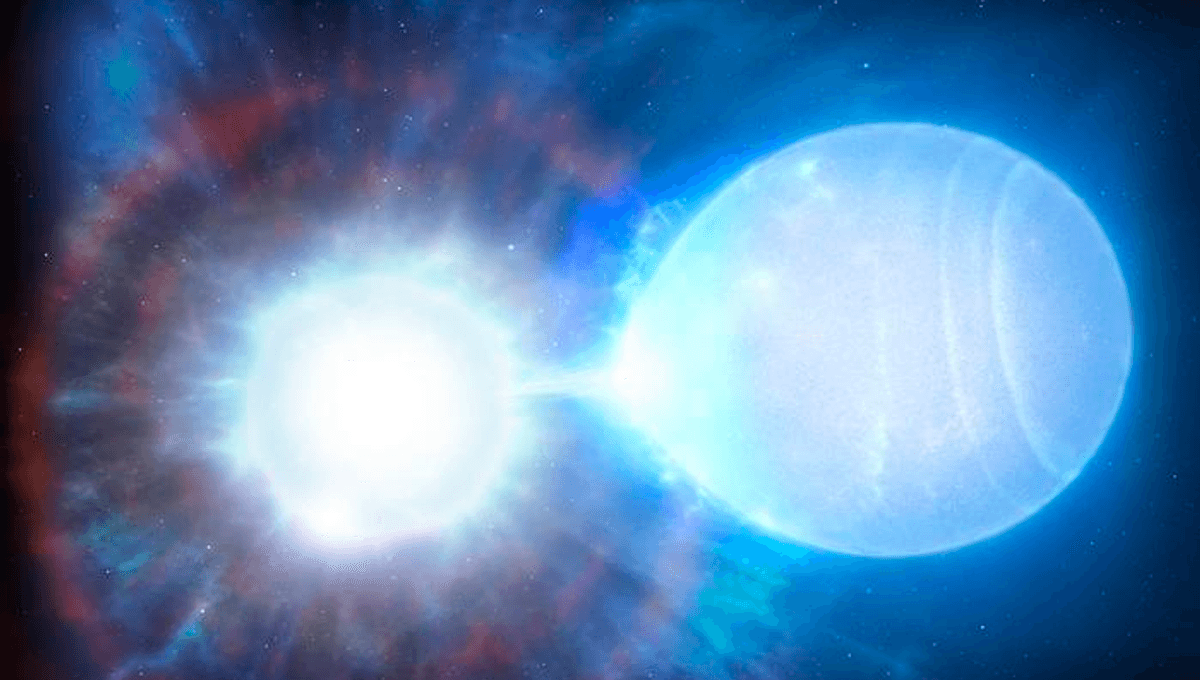
Two white dwarfs are trapped in a decaying orbit that will eventually turn them into a Type Ia supernova. It’s a common enough story in the universe, but this pair is around 160 light years from Earth. That’s outside most estimates of the danger zone, but within some more cautious ones, and would certainly make for a dazzling explosion. However, these events are so far away in time that we need neither assess threats nor prepare to enjoy.
When a white dwarf accumulates enough mass to surpass what is known as the Chandrasekhar limit (1.4 times the mass of the Sun), a Type Ia supernova is triggered. Although less common than the more famous core collapse supernovae, the relative consistency of Type Ias has allowed astronomers to use them as standard candles to map the universe, including identifying the existence of dark energy.
White dwarfs, sometimes known as dead stars since they are no longer producing energy, can get the needed mass from another main sequence star, or another white dwarf. In either case, this occurs when the stars are locked in tight orbits, which slowly decay so they spiral ever closer.
The last type Ia supernova in our galaxy was in 1572. The enormous distances to those we have seen recently have left room for debate as to the frequency of a second white dwarf being involved, known as double degeneracy. The system WDJ181058.67+311940.94 presents quite a contrast – one that is exceptionally close by astronomical standards at 160 light years, and where we know double degeneracy is involved.
If there were a future core collapse supernova that close to home, we would have known about it long ago. Indeed, it would have been one of the brightest stars in our sky. Betelgeuse, the classic example of a supernova in the making, is around 3-4 times further away.
However, white dwarfs start off faint and get fainter as the heat left over from their formation slowly dissipates. Even quite close, they are easy to overlook, but Warwick University PhD student James Munday went on a search for the distinctive light spectrum seen from narrowly separated white dwarf binaries.
“For years a local and massive double white dwarf binary has been anticipated, so when I first spotted this system with a very high total mass on our Galactic doorstep, I was immediately excited,” Munday said in a statement. Some of the world’s largest optical telescopes were turned to the location to confirm that the find was what Munday suspected.
The stars take 14 hours to orbit each other. Allowing for their masses, this means they are 1/60th as far apart as the Sun and Earth. It takes a long time for an orbit like that to decay completely, unless there is a lot of material providing friction to slow them down. Indeed, the estimated timeline to collision is 23 billion years, almost double the current age of the universe.
A Type Ia supernova requires the combined mass of the two stars to exceed 1.4 solar masses, so several pairs of lighter nearby white dwarfs will never make it. That’s not a problem for WDJ181058.67+311940.94, where the larger white dwarf has a mass of 0.83 solar masses, and the smaller one 0.72, making a combined 1.56 solar masses.
Given the immense time it can take for similar orbits to decay, astronomers expect there are many white dwarfs in similar orbits across the galaxy. Indeed, by some estimates, there should be almost 20 within 160 light years of Earth, although some of these will take much longer to explode. “Finding such a system on our galactic doorstep is an indication that they must be relatively common, otherwise we would have needed to look much further away, searching a larger volume of our galaxy, to encounter them,” said Dr Ingrid Pelisoli, the study’s third author.
The only previously known white dwarf pair this close to us with masses large enough to make a supernova is on an orbit of 1.25 days, making their time to contact more than 100 million years.
Besides being close, WDJ181058.67+311940.94 is significant in other ways, including being the heaviest of this sort we have found.
White dwarf pairs are thought to explode in a complex four-stage process. Initially, enough material from the lighter one is drawn off by the gravitational pull of the larger star to cause an explosion on its surface, which then triggers a more powerful one in the core. Some of the material thrown off by that explosion runs into the remains of the smaller orbiting white dwarf, triggering explosions there as well.
The cumulative effect will annihilate both stars entirely, producing a burst of light that, from our current distance, would appear ten times brighter than the full Moon. However, in the time until this occurs, both WDJ181058.67+311940.94 and the Sun will have circled the galactic center many times. Even if the disruption from encounters between the Milky Way and the Andromeda Galaxy does not throw things off entirely, it is likely that we’ll have long since drifted apart. Moreover, by the time the explosion occurs, the Sun will be a white dwarf itself, and the Earth will quite likely have been swallowed into it in its previous red giant stage.
Still, perhaps some aliens on another world will enjoy the sight.
The study is published in Nature Astronomy.
Source Link: Dead Stars Dancing in Our Galactic Backyard Will Eventually Make A Supernova